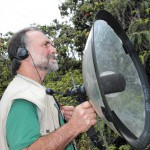The Bird Man Of Kaua‘i Sounds Off
David Kuhn sets out with a large listening device to record the sounds of our island’s endangered birds
David Kuhn of SoundsHawaiian has a knack for capturing the rare sounds of endangered Hawaiian birds including the pueo (owl), puaiohi (thrush) and honeycreepers, such as the akikiki and akekee. He has been recording the sounds of species such as these across the Islands and sharing them with listeners for some 20 years.
While he has delighted in accumulating the whistles and trills of many native birds throughout the years, he is dismayed to hear of the decline in their numbers.
- David Kuhn with his parabolic ear on a Koke‘e trail | Coco Zickos photos
- Kuhn listens for tweets and trills
“It’s a sad story about the endemics,” laments Kuhn.
Kaua’i’s native bird populations have greatly diminished and several are currently endangered. The reason is ultimately human impact, especially during the 1800s, when mosquitoes harboring avian malaria were introduced to the Islands.
“I want people to have these birds as their own, as they are. If you live here, if this is your island, these are your birds,” he says of why he feels so inclined to record their vocalizations.
But Kuhn’s focus isn’t entirely on Hawaiian wildlife. He reveres all the natural sounds of the Islands. When he first began his trade, his focus was primarily on birds; however, it has since shifted to the ocean and even native crickets. Now, he rarely goes anywhere in the Islands without bringing along his parabolic dish, which he uses to collect the intonations.
His mission is to gather, archive and share all the sounds of Hawaii, including those of introduced species such as the shama. Kuhn has gathered some 700 gigabits of recorded sounds and published approximately eight CDs, including Voices of Kaua’i Forest Birds and Mauna Kea Soundscapes.
He also distributes his recordings to Kaua’i Community Radio Station KKCR and other outlets, and often presents the sounds to audiences across the island.
He calls it “conservation through education.”
“That’s a good way to spend my energy,” he says.
His recording intrigue began while on a trip to South America in the early ’90s, where every tour guide carried a recorder and microphone to document the sounds of birds. He realized no one was intensively collecting Hawaiian bird vocalizations at the time, so when he returned from the trip, he immediately began gathering data.
He often traverses the forests of Koke’e to assemble sounds. One of his favorite locations is the Alakai Wilderness Preserve.
“It’s a wonderland of water,” he says regarding the marsh.
The key to his success, however, is to be in the right place at the right time.
“You miss a lot,” he admits. “You’re just not ready to record when something shows up.”
So he often spends an abundant amount of time simply sitting and waiting.
Kuhn’s patience and interest in listening to birds is not a recent trait. His curiosity began in childhood. Born and raised in California, he grew up around feathered creatures and his father managed a duck club. Now, he can recognize almost any Hawaiian bird vocalization, though some native species are difficult to distinguish because of the many different sounds they make.
“It is necessary to make visual confirmation in many cases,” he says.
Kuhn’s favorite bird to listen to is the apapane.
“I’m so grateful for apapane. It’s still always there. You can go anywhere in the Alakai and hear them,” he says. “They have an infinite repertoire of song phrases. They’ve been referred to as random song generators. I’ll never get all of apapane’s sounds.”
Kuhn currently is finishing a compilation called Ka Waiwai O Kaua’i (Water, the Wealth of Kaua’i). For more information, visit soundshawaiian.com.





